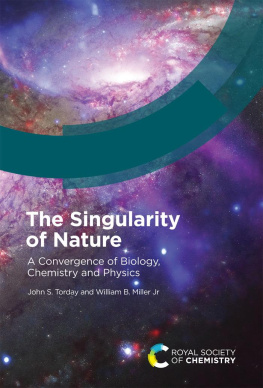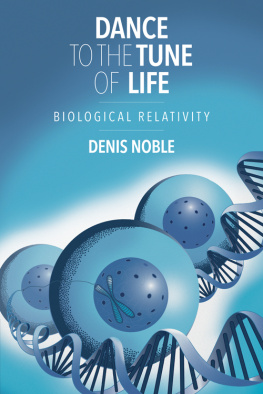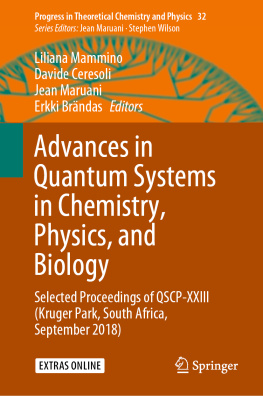Table of Contents
The Singularity of Nature
A Convergence of Biology, Chemistry and Physics
The Singularity of Nature
A Convergence of Biology, Chemistry and Physics
By
John S. Torday
UCLA Evolutionary Medicine, USA
Email:
and
William B. Miller Jr
Banner Health Systems, USA
Email:

Print ISBN: 978-1-78801-797-8
PDF ISBN: 978-1-83916-224-4
EPUB ISBN: 978-1-83916-225-1
A catalogue record for this book is available from the British Library
John S. Torday and William B. Miller Jr 2021
All rights reserved
Apart from fair dealing for the purposes of research for non-commercial purposes or for private study, criticism or review, as permitted under the Copyright, Designs and Patents Act 1988 and the Copyright and Related Rights Regulations 2003, this publication may not be reproduced, stored or transmitted, in any form or by any means, without the prior permission in writing of The Royal Society of Chemistry or the copyright owner, or in the case of reproduction in accordance with the terms of licences issued by the Copyright Licensing Agency in the UK, or in accordance with the terms of the licences issued by the appropriate Reproduction Rights Organization outside the UK. Enquiries concerning reproduction outside the terms stated here should be sent to The Royal Society of Chemistry at the address printed on this page.
Whilst this material has been produced with all due care, The Royal Society of Chemistry cannot be held responsible or liable for its accuracy and completeness, nor for any consequences arising from any errors or the use of the information contained in this publication. The publication of advertisements does not constitute any endorsement by The Royal Society of Chemistry or Authors of any products advertised. The views and opinions advanced by contributors do not necessarily reflect those of The Royal Society of Chemistry which shall not be liable for any resulting loss or damage arising as a result of reliance upon this material.
The Royal Society of Chemistry is a charity, registered in England and Wales, Number 207890, and a company incorporated in England by Royal Charter (Registered No. RC000524), registered office: Burlington House, Piccadilly, London W1J 0BA, UK, Telephone: +44 (0) 20 7437 8656.
Visit our website at www.rsc.org/books
Printed in the United Kingdom by CPI Group (UK) Ltd, Croydon, CR0 4YY, UK
Contents
Preface
The subject of this book was originally outlined in a journal article with the same title by J.S. Torday. The general presenting concept was that because cosmology and biology originated from the Singularity/Big Bang, they share numerous homologies at the quantum mechanical and cellular levels. Such homologies are implemented by chemical, physical and biologic reactions that account for balanced physical reactions as physiologic cellular homeostasis. Although these reactions are all exercised at the level of individual cells, their aggregation through multicellularity permits our perceptions of reality instead of perpetual chaos.
A key determinant in this volume is that the Big Bang produced an equal and opposite reaction based on Newton's third law of motion. This forced relationship represents the foundation of cellular homeostasis by establishing the intracellular negentropic state. In chemistry and physics, reaction sets express combinations of mass and energy on either side of an equals sign. Therein lies the fundamental difference between these sciences and biology. In the case of chemistry and physics, the product of the reaction is stable and predictable. In the case of a biological reactions, the product remains unstable and is never an absolute equality. This dynamic relates to the presence of the two conflicting imperatives of the living state. The definitional negentropic status of the internal cell that must be maintained, yet, this dynamic must be achieved despite consequential conditional ambiguities that define the living circumstance. The basic cell resolves this conflict to maintain internal relative negentropy through the continuous dynamics of chemiosmosis and homeostasis. Together, these three vital living components form the first principles of physiology (negentropy, chemiosmosis and homeostasis).
In living systems, stasis is tantamount to extinction. Biology copes through products of biologic reactions as adaptive offspring, molded by their environment through epigenetic inheritance. Nonetheless, the animate and inanimate must both adhere to the same laws of nature, each reconciling the dualities of the Big Bang in their own manner. From this well-grounded base, a novel cellular-molecular approach to the evolution of physiology based on developmental biology emerges as a continuum from the Singularity forward over universal space-time.
The Royal Society of Chemistry has been dedicated to the advancement of excellence in the chemical sciences since 1841, over twenty years before Mendeleev's periodic table was first published, merging chemistry and physics using atomic number as a normalizing factor. Similarly, the approach to evolution using cell-cell signaling has merged ontogeny and phylogeny into one continuous process. The further recognition that the atom and the cell are both homologues of quantum mechanics has merged physics, chemistry and biology into a justifiable Singularity.
The hypothetical deployment of lipids to form the first cell is predicated on micelles spontaneously forming primitive cells with semipermeable membranes provided the requisite physicochemical separation between the cellular interior and the outward environment upon which life depends. The ability of such structures to deform when warmed by the sun, and reform at night conferred the required memory for evolution to take place.
The recognition of chemiosmosis as one of only three first principles of physiology places chemistry squarely in the center of the evolution of life. The alignment of ions with positive or negative charges on either side of an internal membrane to generate electron flow for bioenergy was essential for the maintenance of negative entropy; the pact with the devil that life has struck for remaining viable.
John S. Torday and William B. Miller Jr
Chapter 1
The Singularity of Nature
1.1 Introduction
When one man has reduced a fact of the imagination to be a fact to his understanding, I foresee that all men will at length establish their lives on that basis Henry David Thoreau, Walden
1.1.1 Prologue
The following is not an exercise in sophistry. We are at a watershed in human history, in which humans are affecting global climate, considering delegating our intelligence to machines, and genetically modifying ourselves. All of this is happening without an understanding of our origins and evolution, Darwin notwithstanding. In light of that, we offer the following insights for your consideration.
Did you ever wonder why there is never a bad color combination in nature? Contemplating that realization has been an enduring focus of our thoughts from the pre-Socratic Greek philosophers, across the breadth of the Aristotelian vitalistic concepts of entelechy, extending to E.O. Wilson's contemporary book, Consilience ( memorably pronounced: Nothing in biology makes sense except in the light of evolution. Any attempt at reconciling chemistry and physics must therefore explain how basic chemical and physical laws can seamlessly yield the biological forms that populate our planet.






